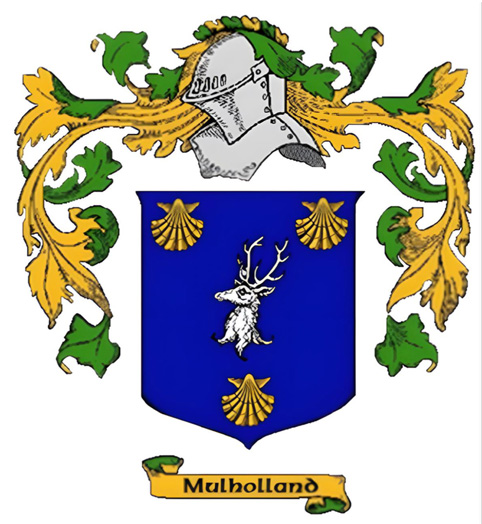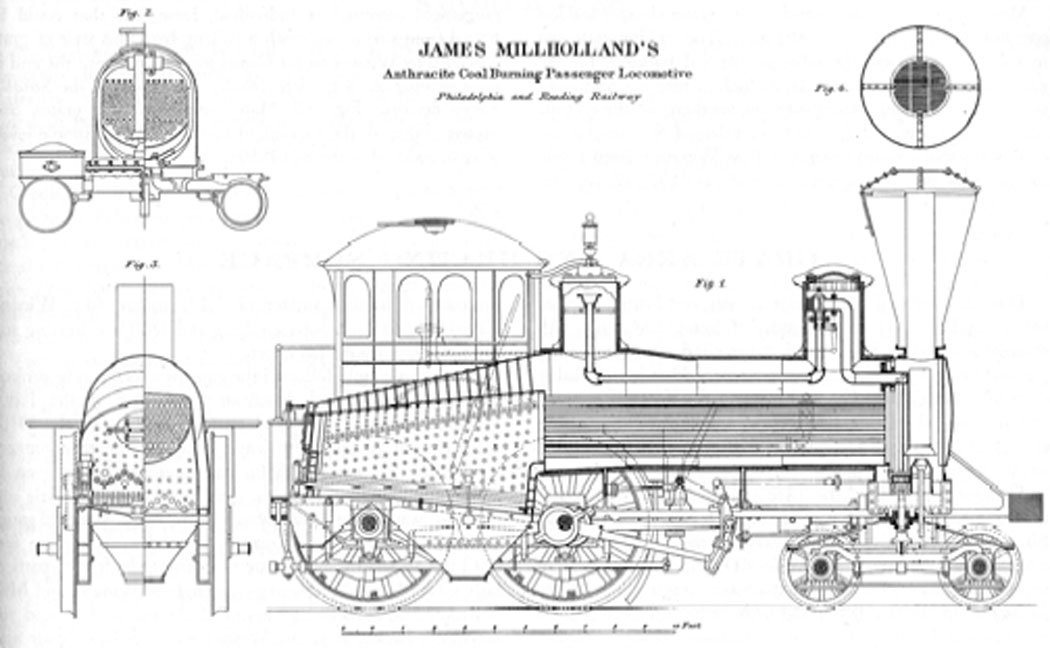 |
The Millholland FamilyChapter 2The Millholland Railroad Legacy |

|

Throughout the years, Millhollands have been employed in various professions, military, law, insurance, banking, machine tool design, doctors, etc. The one consistent profession that seems to run through the family is that of railroading. From the very beginning of railroading in America, Millhollands have been involved.
Our common ancestor, James Millholland (1812-1875) was apprenticed to George W. Johnson, a Baltimore machinist who completed the first steam locomotive in America. When Peter Cooper, who began the construction of the Tom Thumb, got busy on other affairs, he asked George Johnson to finish the build. James was 17 at the time and had a direct hand in the building of the Tom Thumb. It was completed in 1830.
During his career, he became master machinist of several different railroads. Some of his innovations were: cast iron crank axles for locomotives, wooden springs and six-wheel steel freight cars. He also designed and built the first girder plate bridge in the U.S. While at the Baltimore and Reading Railroad, he designed and implemented a fire grate that burned anthracite coal. Anthracite burned hotter and with less impurities than the bituminous coal which was currently in use.
When James became Master Machinist of the Cumberland and Pennsylvania Railroad, he brought one of his sons with him, James Allaire Millholland.
James Allaire Millholland (1842-1911) was associated with the Cumberland & Pennsylvania Railroad and was responsible for setting up their shops in Mount Savage. He was lured away to the Georges Creek and Cumberland by a high salary and a new Victorian home on Washington Street in Cumberland. The home is still there. It sits on the grounds of the Emmanuel Episcopal Church and is being used as their rectory. He became General Manager and later President of the George's Creek and Cumberland Railroad in Cumberland, Maryland.
Continuing the line, Lewis Curtis Millholland Sr. (1875-1945), a son of James A., was Vice President of the Maryland Rail Company manufacturer of light steel rails and his son Lewis Curtis Millholland Jr. (1905-1973) was involved in bridge building.
John Keim Millholland Sr. (1876-1949), another son of James Allaire, was also a railroader. His first railroad experience, in the 1890's, was on the Georges Creek and Cumberland RR - the line where his father was the president. He began as an apprentice machinist and rose to the position of foreman. About 1907 he moved to Grafton, WV to begin working for the Baltimore and Ohio Railroad. While with the B&O he held positions of Assistant Master Mechanic, Yard Master, and Assistant Superintendent of Motive Power. For a short period of time, he was transferred to Keyser, WV . In 1918 he transferred to Russell, KY to work for the Chesapeake and Ohio Railroad as Assistant Roadhouse Foreman. By 1919 he had been promoted to General Foreman. Two years after moving to Russell, in 1920, he transferred to Shelby, KY where he held the position of General Foreman. He remained in Shelby with the C&O for 23 years. He retired in 1943.
William DeVries Millholland (1903-1956) was a son of John Keim Millholland Sr. About 1930, during the depression, the C&O laid off many young men including W.D. Millholland. It wasn't until December 2, 1941, that he returned to the C&O Railroad in Charlottesville, VA as a Fireman. After two years and eight months he was promoted to Engineer on July 4, 1944. He served on the Piedmont and James River Divisions between Charlottesville, Richmond and Newport News, VA. He also served on the Washington and Potomac Division from Charlottesville to Washington, DC with occasional runs to Clifton Forge, VA. He served as Engineer on the Chesapeake and Ohio Railroad until his retirement in 1955 due to ill health.
Henry Millholland (1857-1923), a brother of James A., first got into railroading working for Pennsylvania R.R. in Altoona, PA and with the Baldwin Locomotive Works in Philadelphia. About 1900, he was instrumental in bringing Charles E. Duryea, the "father of the automobile" to Reading, where as a partner of Duryea they formed the Duryea Power Company and manufactured the first successful gasoline automobiles in this Country.
John Hoff Millholland (1867-1897) a half-brother of James A. worked in the engineering department of the Pennsylvania Railroad. While working at the PRR, he studied law and finished his career as an independent lawyer.
Paul Douglas Millholland (1864-1946), another brother of James A. was a civil engineer, he assisted in surveying and constructing the West Virginia Central and Pittsburgh Railway (known now as the Western Maryland Railroad.) Later he was connected with the Georges Creek and Cumberland Railroad in Cumberland, MD. In 1869 he left Cumberland to help construct and later manage the Neversink Mountain Railroad in Reading, PA - the third electric railroad in the United States and first in this country operated by waterpower.
Charles Bruce Millholland (1903-1981) was a playwright who wrote a play “On the Twentieth Century” about a train ride on the Twentieth Century Limited from Chicago to New York. It was adapted into a Broadway musical in 1978. We have the railroads covered from steam engines to musicals!